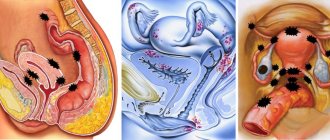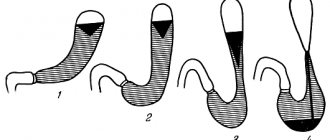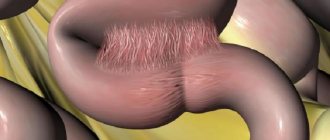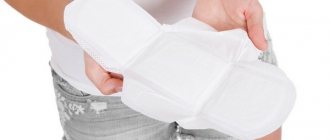Dear readers! Today we are talking about such a delicate problem as uterine prolapse. This, indeed, becomes a problem for many women, which only gets worse over the years. So, according to statistics, such a pathology is diagnosed in every tenth of a hundred women who are diagnosed with this. At the age of up to 40 years, it is diagnosed in 40% of cases, and at an older age, a similar problem is observed in half of women. 15% of all genital surgeries are performed for prolapse or prolapse of the uterus. In this article I will tell you why uterine prolapse occurs, treatment methods, and whether it is possible to correct the situation at home.
Uterine prolapse - causes and consequences
Uterine prolapse, or as doctors also call this pathology, uterine prolapse is a pathological condition in which failure of the ligaments and muscles in the pelvis occurs. Under the weight and pressure of the internal organs on the uterus, the pelvic organs shift downward. First of all, the uterus is subject to displacement, and then the vagina. In addition, the bladder and rectum are affected. If this process is not stopped in time, the uterus may move beyond the genital slit, that is, it will fall out.
The uterus itself also has its own tone. Its normal position is to be suspended in the middle of the small pelvis at an equal distance from its walls between the bladder and rectum.
If the muscles and ligaments are unable to support the uterus in a suspended state, it begins to move downwards. The reasons for this shift may be the following factors:
- Heavy physical work involving heavy lifting;
- Difficult or multiple births;
- Surgical interventions in the pelvis and perineum, in which the integrity of the pelvic muscles is disrupted;
- Deficiency of the hormone estrogen in the blood, which occurs during menopause;
- Obesity, overweight;
- Heredity and genetic predisposition, congenital anomalies, inflammatory diseases and tumors in the pelvis;
- Chronic constipation, hernias;
- Sedentary lifestyle,
- Advanced age.
There are 4 degrees of uterine prolapse. If in the first degree there is a slight prolapse, and when straining the uterus does not come out of the gaping genital slit, then in the fourth degree it is already located outside, outside the genital slit. With this degree, nearby organs are involved: prolapse of the vaginal wall, bladder and anterior wall of the rectum occurs.
The process of weakening the pelvic floor muscles occurs gradually, therefore, when the first symptoms indicating this pathology appear, you must immediately pay attention and begin treatment.
And the first symptoms may be the following:
- a feeling of fullness and the presence of a foreign body in the lower abdomen;
- painful sensations radiating to the lumbar or sacral region;
- frequent urination and constipation;
- the likelihood of bleeding from the vagina;
- menstrual irregularities, painful, prolonged or heavy periods;
- discomfort during sexual intercourse.
As the process progresses, the clinical manifestations worsen and as the condition progresses, the pain becomes more intense, and urinary incontinence develops, which occurs even with a slight sneeze or cough. Incontinence of stool and gases is observed. The urethra and bladder become infected and inflammation occurs, and pyelonephritis develops.
At the last stage, a sensation of uterine prolapse appears in the perineum. The prolapsed uterus becomes infected, inflammation occurs, trophic ulcers form, and mucosal atrophy occurs. When walking, the prolapsed uterus is further injured, bleeding from cracks, bedsores, and severe pain appear. The surrounding tissues become bluish and swollen, blood stagnation and varicose veins of the pelvis and lower extremities appear. All this makes the woman bedridden and she becomes disabled.
The most serious complications include strangulation of the uterus or part of the intestine, which can lead to necrosis of these organs. And only an urgent operation can save a life.
Of course, I repeat, the problem is too delicate and many women are afraid to see a doctor. Although, by starting treatment in the early stages, disease progression and complications can be avoided.
What is uterine prolapse?
Uterine prolapse is a pathology in which the organ moves down into the vagina until it completely falls out, while the cervix remains in its place.
This condition is one of the manifestations of a disease called throughout the world “pelvic organ prolapse.” Uterine prolapse can be found in women of any age.
https://www.youtube.com/watch?v=EFDE-ShGIMI
The uterus is fixed in the pelvic cavity in a normal position by the ligamentous apparatus and the muscles and fascia of the pelvic floor, and the organ’s own tone also plays a significant role in this. As a result of damage to the structures that support the uterus, its prolapse occurs.
https://youtu.be/Tnrmq0ESkng
Uterine prolapse - treatment without surgery
In modern gynecology, uterine prolapse is not considered a terrible diagnosis. Of course, the outcome of treatment primarily depends on the degree of the disease. Currently, there are modern technologies for treating uterine prolapse, which are very effective at all stages.
In the early stages, conservative treatment is recommended; in later stages, surgery cannot be avoided. An important point at all stages of uterine prolapse is treatment with folk remedies, as well as the use of special gymnastics, but more on that later.
Modern gynecology does not consider uterine prolapse a terrible diagnosis, since the disease is very successfully treated at all stages. Although in some cases serious complications of the disease are possible and surgery cannot be avoided. But at any stage of the pathology, treatment must always be approached individually. And no matter what treatment method you choose, you must first consult with a gynecologist. Now let’s look at the treatment of uterine prolapse without surgery in more detail.
What is this anyway?
After diagnosis, a woman is concerned with two questions: What is it and how to cure uterine prolapse?
Doctors call the process of prolapse of the uterus in women uterine prolapse. Essentially, this is the inability of the muscles and ligaments of the pelvis to support the uterus in its normal, “suspended” state.
Hair loss can be treated using different methods. It all depends on the stage of the disease. At the initial stage, you can use folk remedies, special gymnastics, but at the fourth stage you cannot do without surgery.
Uterine prolapse - treatment at home
In the initial stages, doctors prescribe treatment at home. I found a lot of positive reviews on the Internet when women coped with a similar problem at home on their own, meaning without surgical intervention. To do this, they used preparations from medicinal plants in combination with special gymnastics. So let’s look at these two types of treatment in more detail.
Despite the fact that when the uterus prolapses, it is not recommended to engage in heavy physical work, much less sports, but with this problem it is simply necessary! The fact is that when the uterus prolapses, it is necessary to do special Kegel exercises or Yunusov gymnastics. What kind of gymnastics is this?
Lifestyle
What lifestyle should you follow if you have been diagnosed with uterine prolapse:
- It is best to postpone having sex during treatment. At the stage of development of the disease, the woman does not notice any discomfort, but later during sex she may experience a burning sensation and pain. It is better to avoid anal sex altogether;
- During the period of uterine prolapse, it is necessary to use contraceptives, if sexual activity has not been suspended. Although pregnancy is possible, it is better to postpone it until the period of complete recovery, since it puts strong pressure on the internal genital organs, namely the uterus;
- pump up your abs as often as possible , such physical exercise will contribute to the tone of the uterus;
- It is recommended Kegel exercises
- during illness, running should be avoided , since it will only contribute to the progress of the disease;
- Do not ignore the recommendations of the gynecologist under any circumstances, as this threatens uterine prolapse. Subsequently, the organ can be felt by the patient herself during palpation;
- normalize your daily routine and start a balanced diet;
- eliminate bad habits.
Kegel exercises for uterine prolapse
Kegel exercises involve tensing the muscles of the perineum. By straining these muscles, the previous tone of the muscles of the pelvic organs returns. As a result, the uterus returns to its normal position. There are no contraindications for performing this gymnastics.
The positive thing is that you can do these exercises anywhere and anytime, it all depends on your desire. A huge advantage of these exercises: when doing these exercises, no one who is next to you sees that you are doing them. For example, you can do these exercises at home, while doing any household chores, or while sitting at the computer, or when you go to bed. You can do these exercises in transport, at work, while walking, or anywhere!
Don’t worry if you don’t succeed in the first days, the fact is that the muscles are weak and they will not want to immediately obey your will. A positive result can be noted after just a week of regular implementation. You need to do gymnastics every day, you can do a good workout once, or you can do several approaches per day.
And another important point. Once you feel the result, you don’t have to stop doing these exercises. Remember that the pelvic muscles weaken with age? So do these exercises always. In addition to restoring the elasticity of the muscles of the perineum and pelvis, you can get rid of bladder weakness and urinary incontinence.
What are the consequences?
- If treatment is not started on time, this leads to uterine prolapse .
- Intestinal ring prolapse can be fatal .
- Vaginal eversion . This process greatly complicates the clinical picture, since it can lead to uterine abscess, and, consequently, to its complete removal.
- Impaired functioning of other organs . The fact of prolapse of the uterus leads to dysfunction of the bladder and intestines, in addition, they also begin to prolapse, which allows for the risk of prolapse.
A life-saving way to eliminate advanced disease is surgery .
Therefore, it is impossible to delay starting a course of medical therapy; it is necessary to follow the prescribed treatment by the attending physician, which will be supplemented with folk remedies, herbal medicine, and special exercises.
Gymnastics for uterine prolapse
Gymnastics according to Yunusov is also effective. Its essence lies in the contraction of the muscles that are involved in urination. To perform it, you need to tense the muscles of the perineum, simulating urinary retention. This exercise can be performed whenever, wherever and as much as you like. But it must be said that Kegel exercises are more effective and more muscles of the perineum and pelvis are involved.
If you have this problem, it is recommended to do yoga. I have already written about how to start doing yoga at home, read by following the link. Yoga has no contraindications for this pathology. And this video will help you.
Exercises to strengthen the abdominal muscles are encouraged: “scissors”, “bicycle”, “birch tree”, slow raising and lowering of straight legs, etc. When performing these exercises, not only the abdominal muscles are strengthened, but also the pelvic muscles.
Why does it occur
Before we analyze the causes of uterine prolapse, we need to understand how it is supported. The pelvic outlet is closed by three powerful muscle layers that form the pelvic floor. Their importance is difficult to overestimate, since any life processes occurring in this area cannot occur without the participation of muscles. For example, they keep internal organs in the correct position and actively participate in childbirth.
In addition to the muscles, the uterus is supported by the ligamentous apparatus, therefore any disturbances in uterine tone and weakening of the ligamentous apparatus lead to changes in the usual position of the uterus. One of the main factors of drooping is age-related changes. But, according to statistics, pelvic organ prolapse is found in every tenth woman out of a hundred under the age of 30. Therefore, we can say with confidence that old age is not the main reason for the development of pathology.
The uterus may prolapse due to the following negative factors:
- Damage to the muscle layers of the pelvis.
- Birth injuries, application of obstetric forceps, extraction of the fetus by the buttocks.
- Connective tissue dysplasia.
- Severe vaginal lacerations.
- Congenital developmental disorders of the pelvic region.
- Major genital surgery.
- Deficiency of female sex hormones, or more precisely estrogen, which leads to menopause.
- Increased intra-abdominal pressure.
- Too hard physical work.
- Loss of elasticity of muscle tissue due to old age.
Not only one provoking factor, but also several may participate in the development of the process. During pregnancy, slight prolapse of the organ is acceptable. The fetus grows, the uterus enlarges, so it can go down a little. An exception is the case when the pathology was present before pregnancy.
In addition to the above factors, women who have the following problems are at risk:
- Operations in the uterus;
- Regular overexertion, heavy physical activity;
- Numerous labor activities;
- Obesity;
- Chronic constipation;
- Diseases accompanied by a constant severe cough;
- The presence of benign tumors in the pelvis;
- Old age, etc.
All these factors sooner or later lead to various diseases, including prolapse of the walls of the vagina and uterus.
Uterine prolapse - treatment with folk remedies
Herbal treatment for uterine prolapse has been used since ancient times; our grandmothers and great-grandmothers had the problem of uterine prolapse. You understand how much hard work they had to do: this included work in factories and in the fields during wartime, and at home they had to work equally with men. And numerous births also contributed to the development of this disease. They hardly knew about gymnastics then, but they treated themselves with herbs.
Nowadays, herbal treatment along with gymnastics is widely used and brings tangible results. But you need to know that herbal treatment is long-term, you need to drink regularly, without skipping tinctures and decoctions.
What does traditional medicine offer us?
Plantain syrup. Pour 50 grams of dried plantain leaves into a liter of boiling water and simmer over low heat for another half hour, then add a tablespoon of crushed fragrant celery seeds to the broth. Let the broth brew for another 40 minutes and filter through a sieve. Add 500 grams of honey to the cooled broth, stir. Take ¼ cup before meals for a month. If necessary, the course can be repeated.
Infusion with dill seeds. Take equal parts of dill seeds, St. John's wort, chicory and medicinal chamomile. Pour 1 teaspoon of the mixture into a thermos and pour a glass of boiling water and leave overnight. Filter in the morning. Drink the resulting decoction in small portions throughout the day. In the evening, make the infusion again. Take the infusion for 3 weeks, then a 2-week break, the course of treatment is 3 months.
Infusion with lemon balm. Brew 2 tablespoons of lemon balm leaves (fresh or dried) with 2 cups of boiling water in a thermos, leave for several hours to infuse. Take a quarter glass an hour before meals.
Melissa can be brewed with other herbs: lemon balm -75 g, oregano - 75 g, coltsfoot - 100 g. Mix the mixture and brew in the same way as with lemon balm alone. Take a quarter glass an hour before meals.
Tincture with eggshells. Take the shells of 5 eggs, dry them and grind them in a coffee grinder. Grind 9 lemons and mix them together with the shells, leave for 4 days, then add 0.5 liters of vodka to the mixture and leave for another 3 days. Then filter the tincture. Take ¼ glass in the morning and evening until you drink the entire tincture. Repeat the course in a month, there should be 3 courses in total.
Bath with a decoction of pine nuts. Pour 1 cup of pine nuts with 2 liters of boiling water, cook in an enamel pan with the lid closed over low heat for an hour, turn off the heat and leave to brew for another half hour. Pour the resulting broth into the bath and soak in water at a temperature of 38º for 15 minutes.
Consequences and lifestyle
Women suffering from pathology often ask what threatens prolapse? Prolapse is dangerous because it entails prolapse of the vagina, displacement of neighboring organs and disruption of their functionality. When the rectum prolapses, a woman has problems with defecation, usually constipation, but there are also cases of fecal incontinence. The urinary system also suffers, difficulty with the outflow of urine occurs, and stagnation develops, which provokes inflammation and infection. In rare cases, tissue death occurs.
Not only the bladder, but also the threads of the small intestine enter the cavity where the uterus was previously located. The condition leads to failure of the digestive system. The prolapsed vagina and uterus are severely injured, causing unbearable pain with any movement. If left untreated, erosion, abscess, tissue atrophy develops, sometimes the vaginal walls rupture and mucosal defects appear.
Lack of therapy leads to complications such as disorders of the menstrual cycle and ovarian function, and reproductive function completely disappears. Permanent injuries provoke severe bleeding, which threatens the patient’s life. It is necessary to treat the disease, because it is dangerous not only for the pelvic organs, but also for the body as a whole. After therapy, it is important to change your lifestyle, give up hard work, monitor intimate hygiene and visit the doctor on time.
Due to the fact that the pathology causes frequent constipation, it is necessary to eat a balanced diet and monitor your diet. It is advisable to eat light, semi-liquid foods, exclude alcohol, fatty and flour dishes. Sports training should be aimed at gradually strengthening the muscular layers of the pelvic floor. Don't overload yourself with intense training. Maintain wakefulness and sleep patterns, rest more often, walk in the fresh air, sit less, rest more.
Traditional methods of treating uterine prolapse - reviews
I found these reviews in the magazine Healthy Lifestyle, there is such a magazine. Knowing that I write about traditional methods of treatment, my neighbor grandmother brought me several files of this magazine. And here are the reviews - the results of treatment for uterine prolapse I found.
Fist massage
In the morning, when you wake up, lie on your back, stretch your legs, place the fist of your left hand on your stomach, cover the fist on top with your right palm and squeeze. You will get a reinforced double fist. Move this fist along the soft tissues of the abdomen, pressing forcefully, first clockwise, then counterclockwise. Start with 2-3 circular movements, increasing the number of movements every morning. After 20 days, you need to do 20 movements in each direction. A woman does such exercises every morning 20 times in each direction. Her uterus returned to its place, her stool improved, and her hemorrhoids disappeared. It is also useful to do other exercises against uterine prolapse: raising and lowering your legs, doing scissors, raising your knee to your chin, first with one leg, then with the other (2001, No. 10, p. 20)
Cupping treatment
A simple remedy will help cure prolapse and prolapse of the uterus. You need to take a half-liter jar and lie on it so that your navel is in the center of the neck. It will hurt, but you have to be patient and lie there for 3-5 minutes, as long as you can stand it. Then, without getting up, turn on your right side and lie down for another 10-15 minutes. Then lie on your back and tie your lower abdomen with a scarf or elastic bandage and only then stand on your feet. A sign that the uterus is in place will be the absence of pain when lying on the can. This folk recipe is passed down in one family from generation to generation. (2004, no. 9, p. 24).
Abdominal massage
In the evening before going to bed, lie on your back, relax, bend your knees. Use your fingers to walk along the lower abdomen 3-5 times, lifting it slightly. The first few days will hurt a little, but then the pain will go away. (HLS 2011, No. 21, pp. 31-32).
And one more useful exercise. Waking up in the morning, without getting out of bed, roll over onto your stomach and stand in a knee-elbow position, lower your stomach as low as possible, and raise your hips as high as possible, stay in this position for 15 minutes. Then roll over onto your stomach and rest a little without getting out of bed. Do these exercises for at least 20 days, but for better results you can do them longer. By performing this exercise, the uterus will not only return to its normal position, but also constipation will stop, menstruation will normalize, and this exercise will be useful for conception.
Surgery
The most effective and efficient method of getting rid of prolapse and prolapse of the uterus at any stage is surgery. There are several ways to carry out the procedure, the most used include:
- shortening, fixing and strengthening the ligaments that are responsible for holding the uterus;
- suturing of ligaments;
- plastic surgery of the ligamentous apparatus;
- fixation of prolapsed organs using alloplastic materials;
- narrowing of the vagina;
- complete resection of the uterus.
Complete removal of the uterus is performed only in extreme cases when no other treatment methods can help. After surgery, the patient is recommended to undergo a series of physiotherapeutic procedures that will allow her to recover faster and return to a normal lifestyle.
Uterine prolapse - recommendations
- Wear a special bandage in the form of panties, you can buy it at the pharmacy. The bandage prevents prolapse of the uterus and internal pelvic organs. It is put on the naked body in a lying position so that the abdominal muscles are completely relaxed. It is also removed in a lying position. It is recommended to wear it no more than 10-11 hours a day, then it must be removed.
- Very useful, both for prevention and for existing uterine prolapse, cycling 2-3 times a week for 30-60 minutes.
- Do not lift anything weighing more than 3 kilograms.
- When having sexual intercourse, use the “woman on top” position; in this position, the pelvic muscles will be toned as a result of constant contraction and relaxation of the muscles.
Dear readers, the topic of uterine prolapse, as you probably already understood, is a fairly common problem among women. And I have not covered all the subtleties of solving this pathology. To be continued.
Source
Reviews from girls who suffered from the disease:
Mila: “Yes, it’s true, it’s a very unpleasant condition. At first I felt some kind of discomfort, and then after having sex I felt pain in general. I was afraid that there was something in the area of infection and ran to the doctor, who said that it was the early stage of uterine prolapse and prescribed massages. Everything has already passed.”
Karena: “I treated all this at home and didn’t turn to anyone. A friend advised me to take herbal baths and do hand tightening. There’s nothing to worry about so far.”
Anna: “I don’t treat my health negligently, but somehow it happened that I started the disease, the therapy, I’ll say, was very long. It started to let up a little. I’ll say one thing: treat yourself on time and not only with herbs.”
Nurse: “I don’t accept folk remedies. Medicine is something that has been tested and should not cause complications, especially under the supervision of a doctor. I’ve never been sick like this, but I don’t want to swear. And the fact that I treated it or didn’t treat it at home worries me.”
Milusha: “Thank God, I gave birth to a child, then a year later this trouble happened, so my grandmother gave me massages and herbal decoctions. Alive and well!
Treatment
To fully treat uterine prolapse, a woman needs to pay attention to her health and, when the first signs appear, think about what complications this disease may have. If the desire to correct the situation prevails, then the notorious prolapse of the uterus can be easily treated at the 1st stage of the disease. Don't hesitate. High-quality treatment for minor prolapse and pronounced prolapse of the uterine body completely depends on the characteristic symptoms for the course of the disease and the degree of complications. Types: – surgical intervention, operations; – intimate gymnastics, developed through long research and study of effective exercises; – a special diet should be followed by women with intestinal problems to avoid constipation, colic and gas formation; use of uterine rings, bandage; – hormone replacement therapy. The use of special drugs to strengthen the ligamentous apparatus. Some time before starting treatment for a woman, the doctor must have all the necessary information about her health and characteristics in order to know what complications there may be and what will cause them: - the degree of the disease; – disorders caused by illness, chronic diseases and allergic reactions, if any; – diseases related to gynecology and urology; – tolerability of anesthesia during surgery; – age, height and related indicators: blood pressure, pulse. After a complete study of the characteristic features of a woman’s body, the choice of the appropriate type of treatment for prolapse and uterine prolapse follows: conservative and surgical. Since physical activity is strictly prohibited, physical therapy and gymnastics are still present. The exercises you can do are strengthening. Affects the pelvic floor and abdominal muscles. You should perform simple exercises that will not take much time. After gymnastics, there should be relief from unbearable pain in the back, tailbone, and lower back. A successful pregnancy may follow such treatment. And, as a consequence, easy childbirth, restoration of the reproductive functions of girls, adult women with a disease such as unnatural prolapse of the uterine organ. A popular treatment for uterine prolapse, Intimate Gymnastics offers a unique system of exercises for highly effective disease prevention in older people. It is also often prescribed to women immediately after difficult or subsequent births, as a treatment for tissue ruptures in the perineal area. After the exercise called “Cat,” the muscles of the abdomen, uterus, and vagina are strengthened. As you exhale, a woman should pull in her stomach as much as possible, tense all her muscles, and arch her back. As you inhale, return to a calm state. The time to complete the exercise is 10 seconds.
"Bridge"
The popularity of the exercise is not known to everyone. A woman can perform it 5 times. Reduces intra-abdominal pressure, which negatively affects uterine prolapse. As you exhale, you should raise your back. In this case, it is necessary to retract the muscles of the perineum and abdomen. The value of treatment with this exercise is that a woman is able to become pregnant. Facilitates the course and process of childbirth.
"Blinking"
This exercise can be done in any position convenient for you. It is necessary to strain and compress the muscles of the pelvic organs: vagina, anus. Time to complete – 5 seconds. Can be used at any time.
Auxiliary therapeutic exercises:
– normal walking with knees raised; – synchronized raising of arms and high swings of legs; – turns the body with straight arms extended in different directions; – bending forward; - the well-known “mill”. Exercises will not give the effect of complete recovery, but they will contribute to it. As a complementary treatment, exercise is very effective and beneficial. They must be performed daily. Independent work, strengthening muscles with the help of light therapeutic exercises will help your body fight the disease. Another effective and not least used method of gentle conservative treatment is considered to be gynecological massage. It is quite popular. It is performed either on a special massage or a regular gynecological examination chair. Prescribed in the first stages of displacement or minor deviations: – restoration of blood flow in the organs located in the pelvic area; – eliminate adhesive formations; – strengthen the ligamentous connective apparatus and muscles; – the menstrual cycle is normalized; – nervousness and irritation disappear; – the functioning of the urinary system and intestines is stabilized. The duration of the procedure is 15 minutes. The doctor needs to prepare and relax the woman, teach her to tense her muscles correctly and bring them to a state of rest. If even minor pain occurs, the doctor stops the massage. Individually, patients are given estrogens and ointments inside the vagina. In some cases, estrogens are prescribed orally. Surgical treatment involves violating the integrity of the abdominal cavity and performing an operation. And there are many of them: Plastic. The operation is performed in several stages. – Strengthens the bladder and vagina; – characterized by the presence of side effects and possible relapses. The procedure is aimed at fixing the walls of the uterus; stitching tissue elements to strengthen the uterus. The ability to become pregnant, bear a child and give birth to a child after such types of surgical intervention is minimal; – mixed organs are sutured to the walls of the pelvic floor during the operation; – alloplastic materials fix displaced organs.
Consequences of such influence
– rejection, maximum number of relapses; – artificial narrowing of the vagina; - the last resort is used in the last type of operation - removal of the uterus that cannot be treated. Medicine tries to be humane and uses all treatment methods. It combines medications, gymnastics and simple surgical interventions to preserve a woman’s reproductive function and the functionality of her genitals.
Diagnosis of organ prolapse in the pelvic area
What does it mean when women are diagnosed with a disease or suspicion of uterine prolapse, how long does it take for it to manifest itself, and why it happens, you can find out from a gynecologist. During an examination, routine or due to suspected disease, the doctor, after examining the patient in a chair, asks to tense the body, as during childbirth, or simply imitate pushing, in the perineal area directly from the vagina. The rectal area should also be stressed. When the bladder is inflated to its maximum, the degree of displacement and possible prolapse of the uterine body is determined. The specialist doctor also examines abnormalities in the size of internal organs. Inspection of the important walls of the vagina, genital opening, and cervix. The ability of muscles to compress organs in the pelvic floor is observed. If the disease manifests itself and there is a process of prolapse or prolapse after straining the body, the doctor gives a referral to undergo mandatory tests and examinations: - composition of urine for the presence of infections; – smears from the cervix, genital slit, and all vaginal walls; – ultrasound examination – ultrasound. Shows the displacement of the uterus, the qualitative state of the muscles that contract in the pelvic floor; – urography. Studying the performance of the kidneys and bladder using contrast x-rays; – tomography without the use of standard surgical intervention for this procedure. A gynecologist examines the pelvic organs. This includes the organs: ovaries, uterus, fallopian tubes and vaginal cavity. After the gynecologist, in such cases you should consult another doctor - a proctologist and urologist. They will check the process of working the muscles of the anus, sphincter, possible cases: inflammation of the pelvic floor muscles, intestines. The examination process will take some time and only after this will it be possible to make a diagnosis of “uterine prolapse”. The patient is given recommendations and further treatment of the disease is prescribed. It explains in detail what to do if uterine prolapse occurs, what causes and why uterine prolapse occurs. The main classification of types, as well as the degree of occurrence of minor prolapse into the external environment, as well as more serious prolapse of the walls of the uterus
There are types characteristic of the process of mild prolapse and complex prolapse:
– walls, anterior, posterior, at the vagina; the body of the uterus itself; – posterior wall, vaginal vault; – as a consequence of removal of the uterus, the vaginal vault descends. These are general characteristics of the disease process.











